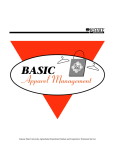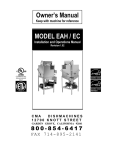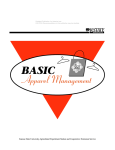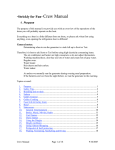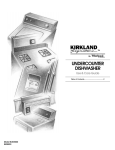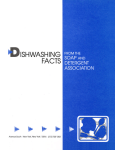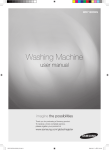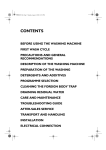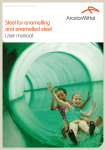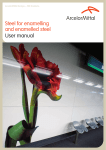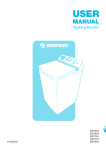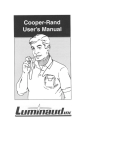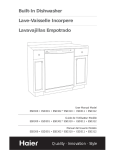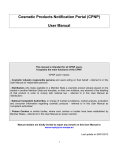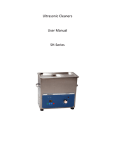Download Wash Wonders 101 - Douglas County Extension Office
Transcript
Leader’s Guide Wash Wonders 101 Although laundering is often perceived to be simple, there are some “tricks of the trade” sure to improve results and add wear-life to any wardrobe. These tricks are worth learning, both from an economic and an esthetic standpoint. Objectives: • To operate laundry equipment. • To learn how to use the many types of laundry products. • To understand the information and symbols provided on garment care labels. • To encourage all family members to participate in and share responsibility with the laundry. Laundry Product Know-How — Handout This material describes the type of products on the market today, their uses, and how to determine what’s in laundry detergent to improve laundering results. Explain the three types of energy balance needed. Explain that lowering water temperature requires added agitation or additional detergent to stay in energy balance. When one goes up or down, the others need to respond. Labels — W hat Do They Tell You? — Handout Have examples of garment care labels for participants to refer to during presentation. Discuss what options they have for garments that have been damaged following care label instructions. For label information see the Soap and Detergent Association’s Web site at: www.cleaning101.com Have examples of the care symbols on hand. Decoding Your Washing Machine — Handout Presents the “mechanics” of using the washing machine and variables that affect its performance. Also outlined are basic washing procedures for participants. Road Map for Results — Handout Provides tips and time savers for laundering. Conserving Energy Use in the Laundry — Handout Conservation tips for consumers. Kids Can Too! Working Together — Handout The motivation for sharing household tasks is to have more time together or to pursue other interests. Beginning with some basic laundry tasks, parents and children working together create a positive learning environment, and a way to share more than just a task together, but common goals. Having children help with family chores may seem to some parents or caregivers as an impossible if not exhaustive delusion. But it doesn’t have to be. Children learn life skills when they share in the responsibilities of the household — the challenge may be in 1 • Kansas State University Agricultural Experiment Station and Cooperative Extension Service • Wash Wonders 101 Leader’s Guide motivating them to accept this obligation. In the publication, Managing Time, Work, and Family — Gett ing Children to Help, MF-2256, nine steps are given to help develop a shared home-management system tailored to the needs of your family. Explain to participants there are some basic steps. Ask them to help determine what these are; sorting, stain treatment, choosing which laundry products for specific loads of laundry, washing, drying, hanging and/or folding. Basic Steps 1. Sort into Washer Loads: • First sort by color (white, light, colorfast, medium, brights, darks). • Sort by fabric type (loosely knitted or woven, sheers, delicate fabric or trims, towels, flannel, fuzzy). • Sort by the amount and kind of soil (greasy or heavily soiled). • Sort by size (mix large and small items). A regular capacity washer would be able to wash one to two twin or full-size sheets and pillowcases, with several smaller items. 2. Preparing the Clothes: • Take time to inspect garments for stains, and pretreat them. Refer to Spot Attack. • Close zippers and other closures. • Empty pockets. • Do mending as needed. 3. Select Laundry Products: Explain the type of energy needed to insure good cleaning results. Refer to Laundry Product Know How for understanding the contribution these products have on results. Have examples for participants to look at. 4. Loading the Washer: Measure and add detergent as washer is filling, then add the clothes. Remind everyone that bulk counts more than weight when determining the size of a wash load. Fill the tub loosely so clothing can move around freely in the water. Larger items should not be wound around the agitator, but placed on one side, balancing the load with other items or towels. 5. Setting the Controls: Choice of water level, wash cycle, wash and rinse temperatures, agitation, and time, are all selected based on the type of clothing washed for each load. Refer participants to Decoding Your Washing Machine. 2 • Kansas State University Agricultural Experiment Station and Cooperative Extension Service • Wash Wonders 101 Leader’s Guide 6. Washing Underway: Check during washing to be sure there is enough water to allow the clothes to move around freely. If not, then reset the water level control to a higher setting and increase the amount of detergent and fabric softener. Always check clothing for stain removal prior to drying. 7. Dryer Details: Stress the importance of moving wet garments as soon as possible to the dryer or line dry. Tip: To keep the washing machine clean smelling try these tips: • Run a cycle of hot water with one cup of bleach once a week. You may do this with or without clothing in the cycle. • For stubborn chemical cleaning, run a cycle of hot water with one quart of white vinegar once a month. DO NOT add clothing to this cycle. • During hot weather and high humidity, keep the lid open when the machine is not in use. Leader’s Note: The following information is more technical in nature. Use at your discretion. Comparing Labels for Detergents Most laundry products vary the amount or combination of the following ingredients, all of which affect a products performance. Surfectant Surfectant is the main cleaning ingredient in detergents. It lowers the surface tension in water, loosens and removes oil from fabrics, and suspends soil to avoid redepositing on fabric. Types include: Anionic — are the most widely used. Lifts dirt from clothes, removes fabric softener residues. Nonionic — are generally only used in liquid detergents. They soften hard water and clean oil stains better. Builders Builders perform several functions, but function to inactivate water minerals that interfere with wash results. Builders have alkalis present to improve cleaning and help suspend soil particles in the water. Types of builders are: Sodium aluminosilicate — removes calcium minerals from hard water. Sodium carbonate — removes calcium and magnesium from hard water. Laurate/citrate — used in liquid detergents to isolate hardness minerals. 3 • Kansas State University Agricultural Experiment Station and Cooperative Extension Service • Wash Wonders 101 Leader’s Guide Other Detergent Ingredients: Granular • • • • • • • • • • • Enzymes are catalysts that help break down starch, fatty, oily, and protein soils. Fabric whiteners create a whitening or brightening effect when exposed to daylight. Opacifiers make product — opaque or reduce transparency. Layered Aluminosilicates provides fabric softening benefits. Sodium Perborate provides gentler bleaching action for fabrics. Activated bleach systems provide whitening at lower water temperatures. Sodium Sulfate is a processing aid used to impart physical characteristics (viscosity, solubility, stability and uniform density) Stabilizing agents are preservatives to protect product’s integrity during shipping and storage. Anti-redeposition agents prevent soil from resettling during washing. Corrosion inhibitors protect the metal machine parts and finishes. Suds control agents moderates the amount of suds during cleaning. Fragrances mask base odors of the ingredients, soil, and package while providing special identity to product. Imparts pleasant odor to clothes. Liquid In addition to those granular ingredients listed above, liquid detergents have: • Buffering agents — maintain the pH of the water during the wash process. • Hydrotropes and solvents — prevent freezing, dissolves organic soils, and keeps product from separating into layers. These solvents are water soluble. • Quaternary compounds — impart sof tness, reduce static, and kill or inhibit growth of microorganisms. Other Resources The K-State Research & Extension 4-H Clothing and Textiles Curriculum, Level II, pages 127-136 includes activities and handouts to supplement this program information. Before administering the lesson, ask participants to fill out the self-evaluation sheet. Following the lesson, ask them to fill out My Plan for Improving My Skills. 4 • Kansas State University Agricultural Experiment Station and Cooperative Extension Service • Handout A Wash Wonders 101 Laundry Product Know-How There are three types of energy needed to insure good cleaning results: chemical energy, provided by the detergent and other laundry aids; thermal energy, provided by the temperature of the warm to hot water; mechanical energy, provided by the agitation of the machine or by hand. These factors interact with each other and need to be in proper balance, if the balance shifts — the others need to increase to insure good results. To understand the laundry process, let’s look at what factors are needed to remove an oily stain. Water alone is not sufficient to remove this stain because the oil repels the water droplets. The detergent supplies the chemical energy needed to break apart the oil and grease. The thermal energy of the water helps dissolve grease and oil inside the stain. Agitation supplies the mechanical energy to pull the stain away from the garment’s surface. The detergent particles then hold the oil and grease suspended in water until it is carried away as the washing machine empties. Liquid, Powders and Enzyme Detergents Liquid detergents work at all water temperatures and are easy to use for pretreating stains. Liquids also have an ingredient that helps to soften hard water minerals. Powder detergents work best at lifting clay and ground-in dirt in warm to hot water. Enzyme detergents are most effective in removing protein and oil-based stains. Presoaking stains 15 to 30 minutes in warm to hot water intensifies the cleaning action of the enzymes. Enzyme detergents must agitate 5 to 7 minutes before adding chlorine bleach to a wash load. Adding bleach too soon stops the enzyme “action” of the detergent and the effectiveness of the detergent. Follow the directions given on the detergent package for the amount to use. Remember, that these recommendations are for an average size load, average soil level of clothes, and an average water hardness. If soil or load size increases, then add more detergent and agitation. Bleach – Chlorine and Oxygen Liquid chlorine bleach is usually 5.25 percent — new products now offer a 6 percent concentration. Liquid bleaches are used for whitening, deodorizing, and disinfecting for bleach-safe fabrics. Never use full strength chlorine bleach on any fabric, especially spandex, wool and silk. Overuse of chlorine bleach damages fabrics by shortening the life of the garments. Evidence of overuse includes rips, tears or even holes that appear mysteriously. 5 • Kansas State University Agricultural Experiment Station and Cooperative Extension Service • Laundry Product Know-How Handout A Caution: Chlorine bleach is poisonous and should never be mixed with ammonia, the fumes are toxic. Gel chlorine bleaches offer splash-free pouring, making unintentional bleach splatters less likely. The thickened bleaches are more expensive than standard bleach — as much as 71 percent more per cup. Concentrated chlorine bleaches offer a higher percentage of bleach than previous products. Theoretically, you do use less bleach per load, but you may pay more for the concentrated bleach you do use — as much as 96 percent more. These comparisons are made only with branded products, so comparisons would be more significant if compared to generic labels. Oxygen bleaches are gentler and safer to use on all fabrics, come in both powder and liquid form, and work well as a presoak for stains. Look for the words “perborate” or “all fabric” on the label. Perborate-based products need extremely hot water for effective bleaching, and some fabrics should not be subjected to severe temperatures. Monopersulfate-based products can be effective at colder temperatures. Oxygen bleaches have a slower reaction time than chlorine bleach, so the warmer the water temperature, the better the product works. Tip: In hard water, all bleach reacts to rust by turning white garments pink. To test, add 1 tbsp. chlorine bleach to 1 C. hot water. If the water turns red or brown (indicating excessive iron) use only oxygen bleaches in the laundry. Pretreatment/Prewash Products For use before laundering, prewash products are convenient, effective and very good at removing set-in, oily-type stains. Available in stick, gels, pumps, and aerosol sprays for pretreating stains. Check aerosol spray labels for solvents — these products are flammable and require ventilation. Keep away from heat or ignition sources. Odor Reducers Baking Soda, calcium carbonate, and activated charcoal all effectively reduce odors. These products help reduce skunks, pet urine, cigarettes and smoke damage odors. Disinfectants Chlorine bleach is an effective disinfectant, but not all fabrics are safe. Refer to above information. Quaternary compounds, also a disinfectant, are safe for fabrics, check for colorfastness prior to using on colors. Available at janitorial suppliers or some drug stores. Refer to Reducing Bacteria in Clothing and Textiles, MF-1130. 6 • Kansas State University Agricultural Experiment Station and Cooperative Extension Service • Laundry Product Know-How Handout A Fabric Softeners For use in either the washer or dryer, fabric softeners: • Reduce static cling, wrinkles, softens, and may slightly reduce soiling. • Reduce drying time, makes fabrics softer and fluffier, and makes ironing easier. • Reduce the absorbency of towels and diapers if excessive amounts are used. • Fabric softeners may reduce the effectiveness of flame retardancy on children’s sleepwear. • Liquid fabric softeners are better at softening and should be diluted prior to adding to the final rinse. Never pour directly onto fabrics. • Dryer sheets are better at treating static cling, and are added at the beginning of the drying cycle. Dryer sheets may cause mysterious stains to appear on certain fabrics. To avoid this problem, (1) use a liquid fabric softener, (2) do not reuse fabric dryer sheets, (3) do not place in the dryer before clothes are added. If oily appearing splotches do appear, pretreat stain and rewash. Prepared by: Marla Day, Extension Associate Apparel, Textiles, and Interior Design Kansas State Research and Extension 7 • Kansas State University Agricultural Experiment Station and Cooperative Extension Service • Handout B Wash Wonders 101 Kids Can Too! Working Together Having children help in laundry responsibilities can begin as soon as they can dress or undress themselves. Children enjoy learning about colors and textures, and a great tool for learning about color and texture of their clothing. Tips for sharing laundry responsibilities among family members: • Have several smaller laundry baskets labeled with pictures and words: whites, darks, brights, fuzzy lint-makers, permanent press, hot water, or special care. • Each day as members change their clothes, empty pockets and close zippers then drop their laundry into the appropriate basket each day. • Older children can pretreat stains – k eeping a stain stick or gel nearby encourages them to use it. • An added benefit to pretreating is that stains come out easier. This saves time and money that would have been spent for replacements and conserves resources. • Folding and placing clothing in the laundry basket reduces the severity of wrinkles them after laundering and saves on ironing. • Never place a wet garment in a laundry basket. Pretreat for any stains, then allow to air dry before placing in basket. • Then when laundry needs to be done, the clothes are all ready to go, making the task much easier to complete. Each day as clothing is removed, a decision about how to care for the garment is made. Whether it is thrown into the corner, the laundry basket, or into the washer, the care and maintenance a garment receives is visible in our everyday appearance. Daily care means clothing lasts longer looks new. Encourage everyone to participate in the daily routine of pretreating, sorting, and folding clothes into laundry baskets. Prepared by: Marla Day, Extension Associate Apparel, Textiles, and Interior Design Kansas State Research and Extension 8 • Kansas State University Agricultural Experiment Station and Cooperative Extension Service • Handout C Wash Wonders 101 Labels — What Do They Tell You? Everyone finds tags uncomfortable, scratchy, and generally just wants them removed. What is it about that little tag sewn into your clothes that makes you want to grab a pair of scissors? Before you grab the scissors, there is some important information on that very tag that could make your life easier! The care label found in every garment is put there for a reason. It tells you some valuable information, but it doesn’t come with a translation or reference guide. This handout will help you understand and use the information provided on the care label. Each care label must have: • One acceptable way to care for the product given, written or using symbols. • Any necessary warnings about the cleaning method given— such as bleaching — that could harm the garment or other items cleaned with it. • Generic fiber name (ex: cotton, spandex). • The percentage of fiber by weight (95% cotton, 5% spandex). • Identifies the manufacturer; name and RN or WPL number (RN 99999). • Identifies the country of origin where processed or manufactured (Made in USA). • If fur; whether it is dyed, colored or bleached, and the animal species. • If wool; whether recycled or not (wool, recycled wool, virgin wool). • Be easy to find, readable for the useful life of the product, and must be firmly attached on all garments sold in the United States. Other information often included on the care label, but not required: • size • finishes applied (permanent press, stain repellent, anti-bacterial, etc.) • color or lot number • special features, design, or brand information How will knowing the fiber content help to care for the garment? Knowing what fiber(s) were used is your first clue for caring for the garment or how durable garments will be. Some fibers are more prone to shrinkage, and others require special care or handling. Knowing a fiber’s characteristic protects your clothing investment and enables you to adjust the laundering process accordingly. 9 • Kansas State University Agricultural Experiment Station and Cooperative Extension Service • Labels — What Do They Tell You? Handout C What do all those pictures with x’s, dots and lines mean on the care label? It’s really simple and applies to washing, drying, and ironing clothing. More dots = more heat, more lines = more care needed, X = do not use that procedure. What if I followed the directions on the label and the product is damaged? Contact the retailer where you purchased the garment to resolve the problem. If they are uncooperative, you can contact the manufacturer directly using the RN number. What can I do with the RN number? Find out the manufacturer of the garment should you need to return a garment to the manufacturer because of product defects. To find out the manufacturer from the RN number, contact your K-State Research and Extension specialist or agent. If you want to contact the FTC (Federal Trade Commission) about the problem, refer to the sample complaint letter that follows. The FTC can’t resolve the dispute, but they do track violations of the law and report frequent violators to the commission. Does label information apply to just the trim used on apparel or to the whole garment? Care instructions are required to provide instructions for the entire, complete and finished garment, as well as the component parts. Is it safe to wash a garment labeled “dry clean only”? A manufacturer is only required to provide one recommended cleaning process. Some manufacturers choose to use dry cleaning as the only method for cleaning. Consumers that choose to risk laundering instead of dry cleaning a “dry-clean only” labeled garment cannot hold the manufacturer liable if the garment is damaged or ruined. Consumers must follow care instructions to be able to resolve problems with manufacturers. Can I cut out the care label? Removing the care label limits any recourse consumers have in substantiating a complaint with a manufacturer. Garments taken to a dry cleaner or laundry service without a care label, place the burden of recourse on the consumer. How do I check to see if a new garment is colorfast? Wash it separately the first time it’s laundered. The second time it’s laundered, try the following either of these two methods to determine whether it’s safe to wash with other garments. Locate a small piece of white fabric, and cut it into two pieces. During the rinse cycle, check the rinse water for dye by dropping in one of the white swatches with the new garment. After the final rinse, check the fabric swatch you tossed into the rinse for whiteness compared with the other sample. If there is no difference in color, wash as usual. Or, apply a little water or detergent along an inside seam and blot with a white paper towel. If color transfers to the paper towel wash the garment separately. 10 • Kansas State University Agricultural Experiment Station and Cooperative Extension Service • Labels — What Do They Tell You? Handout C Sample Complaint Letter Your name, address, city, state and zip code Date Retailer or manufacturer’s name, company contact, address, city, state and zip code Dear __________ : On (date), I purchased (describe the garment) from (retailer’s name and address). The care label indicated that (list information from the labels and tags). Unfortunately, my garment has been damaged because (explain the problem). Therefore, to resolve the problem, I would like you to (state the specific action you want). Enclosed are copies (copies, NOT originals) of my records (receipts, canceled checks, and other documents). I look forward to your reply and a resolution to my problem within (set a time limit). Please contact me at the above address or by phone (home or office numbers with area codes). Sincerely, (your name) Courtesy of the FTC Web site, found at: www.ftc.gov Prepared by: Marla Day, Extension Associate Apparel, Textiles, and Interior Design Kansas State Research and Extension 11 • Kansas State University Agricultural Experiment Station and Cooperative Extension Service • Handout D Wash Wonders 101 Decoding Your Washing Machine As you learned in Laundry Product Know-How, three types of energy are necessary to produce good cleaning results. • Thermal energy is supplied by the water temperature of the wash water. Hot-water wash (120–140°F) Warm-water wash (85–105°F) Cold-water wash (65–75°F) • Chemical energy can be boosted by adding additional products. Bleach (chlorine or oxygen), pretreating stains, presoaking, even using more detergent or an enzyme-based product improves cleaning results. These products can compensate for lower water temperature or less mechanical action. • Mechanical energy is supplied by the agitation of the washing machine. Increasing the amount of time a load is agitated compensates for cooler water temperatures. Water Temperature Cold water is often recommended as a wash temperature for very lightly soiled or brightly colored garments. Using cold water saves energy, but reduces the cleaning effect of detergents. To keep a cold water wash in energy balance, additional steps are needed: • use a liquid detergent • use an oxygen or chlorine bleach as recommended by the care label • presoak heavily stained or soiled garments • pretreat all stains and spots • increase the duration of the wash cycle Warm water is most often recommended for cleaning. Using warm water saves energy (instead of using hot water), increases the cleaning effect of the detergent, and minimizes abrasion to the fabric (for normal loads, no additional bleach, detergent, or agitation is needed). Safe for synthetic fabrics, knits, and wrinkle-free or permanent-press finishes. Hot water is recommended to disinfect bacteria from garments and to remove some stains, or increases the strength of bleach. Safe for white cottons, underclothes, and pesticidesoiled garments. 12 • Kansas State University Agricultural Experiment Station and Cooperative Extension Service • Decoding Your Washing Machine Handout D * Remember to keep each laundry load in energy balance – if chang ing one of the energy components, you need to increase the action of the other two. Water Heater Check Check the hot, warm and cold water temperature coming into your washing machine. Use a thermometer to determine whether adjustment is needed to the water heater. Hold the thermometer in the flow of water coming into the machine. Refer to the temperature chart on page one of this handout. Seasonal adjustments may be needed during cold weather. Caution: Setting the water heater at 110–120°, you will need to use the hot water setting on the washing machine just to get the temperature within the warm wash temperature range. Oh No! Overload! The washer should be loosely loaded with dry unfolded garments. This is NOT the time to pack them in! Clothes must circulate freely to get clean. Vary the size of the items being washed; for example, wash two or three sheets with several smaller items to complete the load. A good rule of thumb for judging the size for top-loading machines — loosely load to the top row of holes in a perforated wash basket or weigh each load using a laundry basket and a set of bathroom scales. Check the user’s manual for weight load and water level recommendations. Cycles, Levels, Rinses and Such Cycles for Permanent Press, Delicates, and Normal Some washers have additional cycles for specific types of finishes applied to garments. These special finishes make them easier to care for, (i.e., permanent press, water resistant, wrinkle free), and these special wash cycles help preserve the finishes for permanent-press or wrinkle-free garments. A cool down rinse minimizes wrinkling during the spin cycle. Delicate cycles are needed for sheer fabrics, loosely knit garments, washable woolens and anything labeled hand wash. The gentler wash procedures of the delicate cycle reduce the abrasion these items receive from rubbing each other. Tip: Use a medium water level setting for the wash and rinse, even for small or very small loads. Doing so minimizes the wrinkling and pulling on seams for items with delicate construction, washable woolens, permanent press or loosely-knitted garments. 13 • Kansas State University Agricultural Experiment Station and Cooperative Extension Service • Decoding Your Washing Machine Handout D Water Level Varying the water level according to the wash load conserves water, detergent, and energy. Judge the water level for each load by placing the unfolded garments in the washer basket and add water to the first level. To insure good cleaning results, remember clothes need to circulate freely. Adjust the water level to the next level as needed, then let the machine fill. Keep increasing the water level to allow clothes to circulate. Remember to adjust the amount of detergent, fabric softener, and wash time based on the adjusted level. Using too little water results in poor washing action and causes garments to show extra wear. Rinses Cold water rinses save energy and are just as effective as warm water rinses, and can be used for every load. Wash Duration Wash time varies by the type of fabrics being washed and how heavily soiled they are. Longer agitation is needed for heavily-soiled fabrics and should be determined by the “dirtiest” garment(s) in each load. Be sure to increase the amount of detergent for heavilysoiled loads. 14 • Kansas State University Agricultural Experiment Station and Cooperative Extension Service • Decoding Your Washing Machine Handout D Four Basic Washing Procedures: Regular Sturdy cotton/linens, no permanent press, delicates or woolens Wash Setting: Regular cycle Water Temp: Whites or heavy soil — Hot Normal soiled colored garments —Warm Bright or dark colors/light soil — Cold Permanent Press and No-Iron Items Oily stains need immediate attention to prevent permanent damage. Wash Setting: Use permanent press cycle. Water level: Medium or higher to avoid wrinkling. Water Temp: Whites or heavy soil —Hot Normal soiled colored garments —Warm Cold water rinses for all loads Delicates Lingerie, washable silks, loosely knit, sheer fabrics, lace trimmed, embroidered, and foundation garments. Never use chlorine bleach on garments with spandex. Use a mesh bag for small items or hosiery. Wash Setting: Use delicate cycle Water level: Medium or higher to avoid excessive abrasion to delicates Water Temp: Use warm or cold to avoid fading bright colors Wool Only wools labeled machine-washable or hand-washable on care label. Never use chlorine bleach. Do not place in clothes dryer unless recommended by care label. Wash Setting: Use delicate cycle Water level: Medium or higher to minimize shrinking and pilling Water Temp: Cold water wash and rinse Prepared by: Marla Day, Extension Associate Apparel, Textiles, and Interior Design Kansas State Research and Extension 15 • Kansas State University Agricultural Experiment Station and Cooperative Extension Service • Handout E Wash Wonders 101 Road Map For Results Sorting Secrets Color — Separate whites from colors and darks from brights. Using different wash temperatures for these color loads, reduces the chance of color loss or transfer to a lighter color fabric. Fabric — Sort according to fabric type and texture. Surface — Separate lint givers from lint takers. Construction — Loosely knit or woven fabrics, lace trim or delicates need special care cycles. Dirt — Separate according to the amount of soil, light soil vs. heavily soiled. Pesticides — Never wash pesticide-soiled garments with the regular wash. Prep Time Insure good laundry results by: 1. Closing zippers, hooks and eyes, and hook-and-loop tape to prevent snagging. Dangling drawstrings and ribbons should be loosely tied to avoid entangling with other garments. 2. Empty the pockets and brush away lint or dirt. Melted gum, candy or crayon creates extra work! 3. Remove unwashable items, such as belts, trim, and jewelry. 4. Repair prior to laundering. Rips and tears tend to grow if left untreated during laundering. 5. Treating spots, stains, and heavily-soiled areas with pretreatment stain products. 6. Turning permanent-press garments inside out helps prevent pilling, a common problem for permanent-press garments. 7. Place hosiery, delicate, or small items in a mesh laundry bag. Ring around the collar! Rub heavily-soiled collars and cuffs with a liquid detergent or pretreatment product before laundering. Other stains need special care too, just watch out — if you use a product that happens to soften your nail polish (petroleum distillates) you may end up with polish on the clothing you are treating. 16 • Kansas State University Agricultural Experiment Station and Cooperative Extension Service • Road Map For Results Handout E Check the water. Hard water is present if you notice these effects in your home: • A ring around the bathtub. • It is difficult to get shampoo or soaps to lather easily. • A white residue forms around faucets and drains. • Fabrics feel stiff, not fluffy. If you think you have hard-water problems, add more detergent or use a water softener in the wash water. Choose the right wash temperature. Sort laundry by color and water temperature. Washing garments in water too hot or cold produces wrinkles, dye loss, shrinkage, even dye transfer. Don’t overfill the washing machine. Detergents remove dirt and the minerals in hard water by (1) holding them in suspension, (2) preventing them from being redeposited on the fabric; and (3) carrying them away in the water. When the washer is overfilled, this process is hindered and results in clothes that are not clean and overly wrinkled. Reduce bacteria in the laundry. • Separate laundry items that may have more bacteria on them such as dishrags, kitchen towels, or underwear. • Wash hands after placing dirty laundry in the washing machine and when moving the wet laundry to the dryer. • Wash and dry garments in the hottest temperature safe for the fabrics. • Use a disinfectant such as chlorine bleach or quaternary compounds. • At public laundry facilities, when laundering infants’ clothing, or following any contagious illness in the family. The 3 P’s of Stain Removal • Promptness • Patience • Perseverance Avoid extra work! Remove the clothes from the washing machine as soon as the wash cycle is complete — you avoid extra wrinkles. Should you discover wrinkles later — rewashing them solves the wrinkle problem, but causes an extra expense. Discovering them days after — they may have mildewed, causing you to purchase new garments, and the wash basket will likely 17 rust! • Kansas State University Agricultural Experiment Station and Cooperative Extension Service • Road Map For Results Handout E What’s Average? Laundry products always give a recommended amount to use based on an average load, but how does this translate to your family? Refer to the instructions on the product label. Average conditions list these criteria: • A 5 to 7 pound load of clothes √ Determine the weight of the load by using a bathroom scale. Weigh an empty laundry basket, then place a load of clothes in the basket and re-weigh. The difference between the two is the weight of the load. Doing this activity will determine what is average for your washing machine. • Moderate Soil √ Soil level is determined by how soiled the dirtiest garment is for each load. • Moderately hard water √ Refer to page 2 of this handout for indicators of water hardness. • Average water volume √ 17 gallons for top loading washers, or four to eight gallons in front loading washers. Adjust the amount of laundry product for: • Larger loads, heavier soil, hard water, and large capacity washers. Use slightly less for soft water or lightly-soiled loads. Prepared by: Marla Day, Extension Associate Apparel, Textiles, and Interior Design Kansas State Research and Extension 18 • Kansas State University Agricultural Experiment Station and Cooperative Extension Service • Handout F Wash Wonders 101 Conserving Energy Use In The Laundry Clothes washer In most American homes, a considerable amount of hot water is used for washing clothes. Consider a machine that has the ability to control water level and an automatic cold-rinse cycle when purchasing a washing machine. When you use your washer, follow these suggestions to save energy: • Pre-soak heavily-soiled clothes. • Fill the washer according to the load level, such as low, normal, high, or extra high. • Follow the manufacturer’s instructions for adding detergent. • Use as low a water temperature for the washing cycle as will give satisfactory cleaning. • Remember that cold and medium water temperatures may vary with the season. • Always use a cold rinse cycle. • Use your washer during “off-peak” hours or on weekends. • Follow maintenance instructions found in the owner’s manual. Clothes dryer A dryer evaporates water from clothes and minimizes wrinkling by tumbling the clothes. Water evaporation requires heat — large amounts of it. Heating costs money, but there are ways to use the dryer to make it more economical to operate. Using a dryer with a variety of cycle settings allows you to set a temperature suitable for the fabrics being dried. Follow these economy suggestions: • Extract as much water as possible from clothes before putting them in the dryer. • Sort dryer loads and set temperature by fabric type. • Do not overload the dryer. • When possible, run consecutive loads to take advantage of dryer warmth. • Try reducing drying cycle time, hanging garments while still slightly damp. • Clean the lint filter after each load. • Check and clean the outside vent monthly. • Dry clothes outside on a clothesline when possible. 19 • Kansas State University Agricultural Experiment Station and Cooperative Extension Service • Conserving Energy Use in the Laundry Handout F Vacuum the lint from the motor housing three or four times a year. Follow the manufacturer’s maintenance instructions listed in the owner’s manual. Permanent-press fabrics absorb less water than conventional fabrics and therefore require less drying time. By using permanent-press clothing and bed linens, you will reduce drying and ironing time while saving energy too. Prepared by: Marla Day, Extension Associate Apparel, Textiles, and Interior Design Kansas State Research and Extension 20 • Kansas State University Agricultural Experiment Station and Cooperative Extension Service •




















